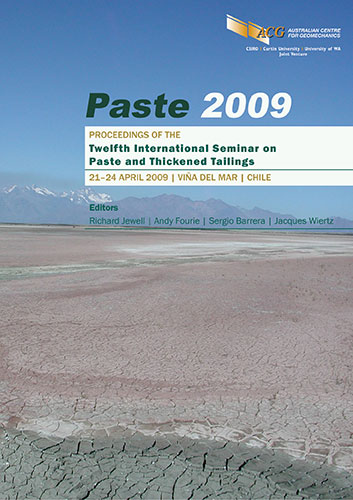Mineral Paste Comparison Between Copper and Iron Tails

|
Authors: Hernández, CA; Pizarro, EA; Molina, JA; de Araujo, AC; Valadão, GES |
DOI https://doi.org/10.36487/ACG_repo/963_6
Cite As:
Hernández, CA, Pizarro, EA, Molina, JA, de Araujo, AC & Valadão, GES 2009, 'Mineral Paste Comparison Between Copper and Iron Tails', in R Jewell, AB Fourie, S Barrera & J Wiertz (eds), Paste 2009: Proceedings of the Twelfth International Seminar on Paste and Thickened Tailings, Australian Centre for Geomechanics, Perth, pp. 47-55, https://doi.org/10.36487/ACG_repo/963_6
Abstract:
Low-water content mineral tailings disposal has been the focus of study of many scientists, academicians, and engineers in the mining industry. In countries like Canada and Australia, several mineral paste tails disposal pilot and industrial scale test have been successfully carried out, both surface and underground. Chile is the world’s largest copper producer and the main deposits are located in the country’s driest region, therefore, the Chilean companies with concentration operations have focused on the use of sea water, such as Minera Esperanza project (given its favourable geographic location compared to other operations), or extra water recovery through tails thickening, that makes mineral paste technology attractive. Some companies have already undertaken preliminary studies and pilot tests, but in Chile, it is still a new technology. Brazil, South America’s largest steel producer, has also worked on this idea. Some iron deposits have begun to dispose of their tails as mineral paste. These tailings contain a high iron concentration, as it could be expected in some Chilean copper deposits, located between regions 3 and 4. This work aims at comparing the properties of mineral pastes, such as consistency, fluidity and viscosity, from the samples studied in the UFMG, Brazil (high iron content), to recent studies conducted by UNAP, Chile, using Chilean tailings (high magnetite content).
References:
ABNT – Associação Brasileira de Normas Técnicas (1998) Norma para concreto – determinação da consistência pelo
abatimento do tronco de cone – Nbr Nm 67, Rio de Janeiro, pp. 1–8.
Boger, D.V. (2003) First workshop of minerals processing and tailings rheology. In: International Seminar on Paste and
Thickened Tailings, Melbourne, Australia, Australian Centre for Geomechanics, Annals in Electronic Media,
2003, CD 1.
Clayton, S., Grice, T.G. and Boger, D.V. (2003) Analysis of the slump test for on-site yield stress measurement of
mineral suspensions. International Journal of Mineral Processing, Melbourne, Australia, N. 70, pp. 3–21.
de Araujo, A.C., Valadão, G.E.S. and Hernández, C.A. (2004) Nueva aplicación de los relaves de hierro: III Congreso
Internacional de Minería, Metalurgia y Materiales, Annals in Electronic Media, Iquique, Chile, 2004, CD 1.
Hernandez, C.A., Araujo, A.C., Valadão, G.E.S. and Amarante, S.C. (2005) Pasting Characteristics of Hematite/Quartz
Systems. Minerals Engineering, Vol. 18, pp. 935–939.
Jung, S.J. and Biswas, K. (2002) Review of current high density paste fill and its technology. Mineral Resources
Engineering, Vol. 11, N. 2, pp. 165–182.
Kwak, M., James, D.F. and Klein, K.A. (2005) Flow behaviour of tailings paste for surface disposal. International
Journal of Mineral Processing, Vol. 72, pp. 1–15.
Sofrá, F. and Boger, D.V. (2002) Environmental Rheology for Waste Minimisation in the Minerals Industry. Chemical
Engineering Journal, Melbourne, Australia, Vol. 86, pp. 319–330.
Vietti, A. and Dunn, F. (2002) The thirsty business of diamond mining. High Density and Paste 2002 Seminar,
Santiago, Chile, Annals in Electronic Media, Santiago, April 2002, 1 CD.
Paste 2009, Viña del Mar, Chile 55
© Copyright 2025, Australian Centre for Geomechanics (ACG), The University of Western Australia. All rights reserved.
View copyright/legal information
Please direct any queries or error reports to repository-acg@uwa.edu.au
View copyright/legal information
Please direct any queries or error reports to repository-acg@uwa.edu.au